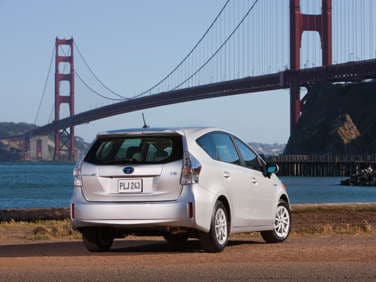Recent Articles
Popular Makes
Body Types
Krome on the Toyota Prius and Prius v

I spent this morning at a ride-and-drive event for the newest member of the Toyota Prius family—the Prius v—and came away duly impressed with its fuel efficiency. In about 40 miles of driving, some of it in stop-and-go traffic and none of it on the freeway, the plus-sized Prius turned up about 43.7 mpg—which is actually a bit better than the 42 mpg combined Toyota expects to see from the EPA. Now, some at the event thought that represented a surprisingly steep drop-off as compared to the standard Prius, which rings up a 50-mpg combined mark, but it certainly represents a huge improvement over a segment explicitly targeted by the Prius v: smallish crossovers.
That's a segment still waiting for the kind of wholesale jump in fuel efficiency that has made 40 mpg the new benchmark on the car side of the business, so there's a huge window of opportunity here. The question is: Does the Prius v have what it takes to take advantage of the situation?
The Prius Advantage
Let's start by taking a look at the Prius itself, though. Sporting a gaudy EPA line of 51 mpg city/48 mpg highway/50 mpg combined, the car is classed by the agency as a "Midsize Car." As such, it delivers some 78 percent better combined fuel efficiency than the thriftiest gas-only mid-size sedan, the 28-mpg Hyundai Sonata. That's obviously a serious advantage for Prius. Compared to a less-economical mid-sizer, like the Chrysler 200 (EPA combined rating 24 mpg), the Prius benefit goes up to more than 108 percent.
Even against the Chevrolet Cruze Eco, which can achieve 42 mpg highway, a comparison of combined ratings show a 51 percent benefit for the Prius, since the Cruze Eco gets "only" 28 mpg city, bringing its combined number to 33 mpg. To put this into context, the Prius has a bigger advantage in combined fuel efficiency over the Cruze Eco than the Cruze Eco has over a four-wheel-drive Chevy Tahoe.
It's a stark reminder that all those new-generation small cars that claim to have "hybrid-topping" fuel-efficiency numbers are telling only half the story—and unsurprisingly, it's the half that puts them in the best light.
The chief benefit of a hybrid powertrain, of course, only comes out during lower-speed, urban-type driving, which represents a significant chunk of most people's daily travel. For what it's worth, the EPA assumes motorists are doing 55 percent of their motoring in "city driving."

Prius vs. Prius v
Things are a bit different, though, when you look at the small crossovers. The Chevrolet Equinox remains the gas-only fuel-efficiency leader in the segment, thanks to its 22/32/26 EPA line, but all the mainstream players are clustered in the 24-26 mpg range in terms of combined ratings; also, the Ford Escape Hybrid can attain 32 mpg combined.
Keeping in mind the Prius v's combined EPA rating is 42 mpg, you can see how its advantage over its competition is a notch or two lower than that of the "regular" Prius. For example, in a comparison against the Equinox, the Prius v gets about 61 percent better combined fuel efficiency; side-by-side with the Honda CR-V, with a combined rating at the lower end of the segment, the Prius v offers 75 percent better fuel economy.
The bottom line: When you look at the vehicles and segments in which the Prius and Prius v are competing, you can't get away from the fact that the Prius offers drivers a noticeably larger fuel-economy advantage over its rivals than does the Prius v.

Sizing up the Competition
But the thing is, that stuff doesn't mean Toyota is somehow slipping up. A notable part of the issue here is that the Prius is a smaller overall vehicle than any "real" mid-size sedan, while the Prius v is bigger than all of its crossover rivals except for the usual outlier here, the Equinox. And that, in turn, gets to what will no doubt be the biggest challenge for the Prius v. While the Prius certainly has a distinctive shape, it's still just a massaged five-door liftback; on the other hand, the Prius v, in terms of exterior design, is never going to be confused with a crossover.
To achieve the low coefficient of drag that's necessary to its high fuel-economy ratings, while still being able to hold more cargo than many small crossovers, the Prius v had to eschew the boxy, squared-off appearance even the sleekest crossovers have. Instead, it's relatively low, long and smooth, like a station wagon, or perhaps a mini-minivan.
That's good for fuel efficiency, and it's good for interior space, but I'm not sure it's going to be good for sales—or at least sales from people who would otherwise buy a crossover.
